Table of contents
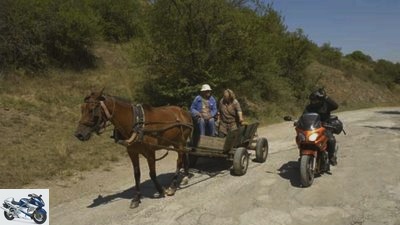
Daams
to travel
On the way: Bulgaria
On the way: Bulgaria
Europe’s back
Bulgaria has more to offer than cheap package holidays on the beaches of the Black Sea: a mountain range up to 3000 meters high, lots of old cultural treasures and deep insights into Europe’s bare back.
Klaus H. Daams
10/09/2008
The bouncer shakes his head – and invites us into the restaurant anyway with an inviting gesture “Green World”. Huh? What now – in or out? But anyone who has done a little research before the trip to the Balkans knows that shaking your head here – in the post-communist space-time continuum, so to speak – means approval, whereas nodding means no. So there is still something to eat here at 11 p.m., in the middle of the not very cozy pampas just behind the border. And that’s the only thing that matters at the moment.
An hour ago we entered Serbia with the obligatory motorcycle disinfection, found a modest room in the border town of Dragoman and are now standing in front of this almost intergalactic supply station called the Green World. “Come on and then go on, impeccable service, cheap”, advertise the flyers and even show swimming pools and volleyball courts. Wow! There is lettuce, mushroom soup with meat and a tomato and pepper paste called Ljutenitza. The operation is not only flawless, but extremely attractive. An arrival that makes you get over the fact that there is currently no water in the hotel until the next morning. Welcome to Bulgaria.
Crossing the mountainous south to the Black Sea in an arc – that is roughly the plan for the next few days. In order to avoid the nearby capital Sofia as far as possible, we are looking for the branch to Breznik in Slivnica. Not at all easy, as many of the signposts are written in Cyrillic. And unlike the day before yesterday in Montenegro, there is hardly anyone who speaks English or even German. At least it succeeds in triggering a crackling Bulgarian thunderstorm of words at a bus stop, which somehow gets us on course. After the bridge on the right – and then straight ahead. Finally, potholes and sunflowers greet us as far as the eye can see. Trying to hit at least a bit of asphalt now and then requires the full width of the street. But apart from the occasional donkey or horse-drawn cart, hardly anyone comes across. “Germania”, laughs a peasant with a glittering gold tooth from his driver’s seat. Memories of the old, pre-Soviet brotherhood in arms with Germany during the two world wars? From Breznik, finally, signposts in Latin script. Probably the result of joining the EU in 2007. Brooaammm – a local Fireblade tears up the monotony on the E 79 near Dupnica and shows the good relative CBF 1000 times quickly that there are more than 200 things easy on the country road.
Buy complete article
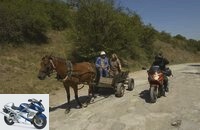
On the way: Bulgaria
Europe’s back
12 pages) as PDF
€ 2.00
Buy now
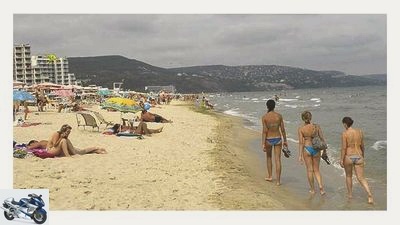
Daams
Beach strollers near Albena.
We are on the way to Rila Monastery, the most magnificent landmark of the Orthodox faith in Bulgaria and a top tourist attraction. Surrounded by the almost 3000 meter high peaks of the Rila Mountains, located in a narrow valley basin and only accessible through a narrow gorge. At first glance, its striped design looks like art out of a Haribo liquorice bag. The center of the complex is the so-called Katholikum, a three-aisled cross-domed basilica, which is covered with lavish frescoes at every free point of ceilings and walls. Inside, black-robed monks with flowing full beards. One of her predecessors, monk Raphael, once demonstrated what human patience is capable of, and for twelve years, 1790 to 1802, carved a cross with 650 tiny figures. Tragically, the effort subsequently cost him his eyesight, but the Raphael’s Cross is today one of the most important exhibits in the monastery.
Unfortunately, the guest rooms here are just as occupied as those in the nearby Hotel Pchelina, so we have to start again. So back through the valley, then a piece of the E 79 to Simitli and from there to Bansko, the gateway to the Pirin Mountains. As the most important winter sports center in Eastern Europe, Bansko has a well-developed tourist infrastructure and even a Kempinski hotel. On the other hand, a helpful moped driver guides us to the cozy Duata Smar? A guesthouse in the old town.
In front of the Church of Sveta Troica we get to know Plamen Sivka. The 49-year-old former Mercedes worker from Berlin-Tempelhof is busy trading icons and other treasures on the loading area of a former Kfor off-road vehicle with glued-on bullet holes. In the middle is an original Glashutte pocket watch with a swastika on the dial. “It is always the same: the party comrades of the past are now the capitalists of today”, the enterprising Plamen summarizes the situation in the country. “There is no longer a middle class. 90 percent of Bulgarians are dissatisfied, while the rest live like maggot in bacon.” In any case, he is not gnawing at the hunger cloth. He says he has already been offered 150,000 euros for his coin collection. After all, it contains treasures from the time of Alexander the Great.
A few meters away is the bombastic statue of the monk Paisij Chilendarski (1722 to 1773), who was the first to write the history of Bulgaria. From the beginnings in the seventh century to the 500 years of Ottoman rule and the associated existence as a Turkish province. After the collapse of the Soviet Union, change in the once communist Bulgaria, unlike its neighbors Romania and ex-Yugoslavia, took place quietly and peacefully on the political stage. The first free elections took place on June 10, 1990, admission to NATO in 2004 and to the EU in 2007. The construction site dust that bites in the eyes illustrates the at least economic upswing in the country.
We continue towards Vihren, the highest mountain in the Pirin Mountains at 2914 meters. A bumpy pleasure that finally comes to an unspectacular end at a lift station. A six-day ski pass costs the equivalent of 140 euros. Little for us, but a hell of a lot for a country in which the majority of the population often barely have a monthly income of 100 euros.
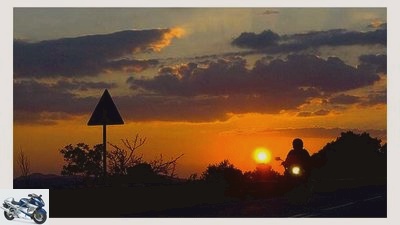
Daams
The former holiday paradise of the East has more to offer than beaches on the Black Sea.
Goce Delcev, Dospat, Yagodinska – 150 entertaining and lavishly winding kilometers of country roads just above the Greek border. The asphalt is often questionable, but what does it matter besides having fun? The lovely landscape is reminiscent of the Black Forest and the Vosges. If it weren’t for the poor Roma families who repeatedly struggle up the slopes in their horse-drawn carts. This ethnic group in Bulgaria comprises 390,000 members, for whom even exemplary anti-discrimination laws, grants and housing programs hardly improve living conditions in the long term, but rather provoke envy and resentment from many locals, who are also not doing well.
It breathes icy from the mouth of the Jagodinska Cave, which at Jagodina allows a captivating view into the interior of the earth and already has traces of living from the Neolithic on its walls. Today it is the longest stalactite cave in the mountainous Rhodope Mountains.
The rear-view mirror hardly manages to capture the panorama of rocks, trees and a sinking ball of sun that accompanies our steady eastward course at Grohotno. A focused look ahead is then required on a real mountain special test between Stojkite and Smoljan, where the four-cylinder impressively stages its sporty genes. The moon is already in the sky when we finally reach Smoljan, where Bulgarian flags flutter hopefully on the shell of the place. The city is not only the highest, but also the longest in the country at ten kilometers. Thank God a taxi driver shortens the search for a room and takes us to the three-fired house recommended in the travel guide, Milena Yurukowa’s guesthouse. The landlady not only speaks German, but also conjures up something to eat on the table in no time at all. Vegetable soup, salad, herb sauce, stuffed peppers, chicken, garlic onions, sugar peas, potatoes – could easily become an export hit.
We stay on the east course, sometimes holterdipolter on bumpy streets, sometimes floating over fresh asphalt financed by the EU. The Bulgarian south – a rather ambivalent region: On the one hand, there are optimistic projects such as a new sewage treatment plant here and a modern overpass there, which seem to have fallen from the sky like manna. Then again villages without any chocolate side, but with decayed houses with plastic film fluttering in their empty window sockets.
Madan with its two mosques, Fotinovo with a lamppost as a minaret, from which three loudspeakers call out tinny to prayer, the smell of grilled suckling pigs somewhere near Makaza and the taste of neon-green plastic limo at a gas station in the void – stations on a Sunday afternoon. On the roadside, cars protected from the heat with blankets and boxes are waiting for colder times. Whole batteries of carefully stacked firewood for the winter reveal that these are coming. A discarded omnibus couple at Tokacka dreams of life after the scrap press. Just as useless as the old police station near Ivajlovgrad. This is a reminder that the Iron Curtain once separated the worlds here. Greece begins a few kilometers south. Strangely enough, the border with the neighbor is still closed. Opening and rapprochement are slow. A little later, only one intrepid harbinger of the near west crawls well armored in front of our wheels – a Greek tortoise.
Another 60 kilometers to Ljubimec, just the right dose before the after-work beer. Quiet meandering along a reservoir before the road winds its way up out of the valley. An eagle is in the sky, giving the signal for a bold climb for the 1000 with the proud wing in the tank emblem. With powerful pressure from all four cylinders, the CBF sweeps up the mountains. In the middle of the ascent we see a Roma camp off the road. Extremely depressing. Ljubimec literally marks the crossing point of the journey: It is exactly 285 kilometers from there either back to Sofia or further east towards Istanbul. We decide on the golden mean, quarter directly behind the signpost in the Motel Boliarka. Now it’s not far to the Black Sea. After four sweaty hours through the flat, unspectacular landscape, the industrial and port metropolis of Burgas emerges from the haze. With difficulty and only thirsting for the beach and cooling, we struggle through the city. The nearby rocky bay of Pomorie turns out to be a flop, the water is murky, the banks littered. So go on. It gets better in Nessebar. “Come with me, journeys for the discerning”, stands on a two-story bus that is parked in front of a bed castle in the village. Trolleys clacking, horse-drawn cabs trot – welcome to Bulgaria from the travel catalog, to the “Pearl of the Black Sea”. But it can also be different, at least in the old town, which has been ennobled as a World Heritage Site by UNESCO and is picturesquely resplendent on a peninsula. There we find – thanks to a tip from Milena Yurukowa from Smoljan – with the Hotel Stankoff, a nice place to stay right on the promenade (keep left in front of the city gate). Vis-a-vis start the excursion boats to the infamous Sunny Beach of Slãncev Brjag. In midsummer, there is sizzling and tanning in a similar style as in Torremolinos in Spain or in Rimini on the Italian Adriatic Sea.
The coast here on the Black Sea stretches 350 kilometers between Romania in the north and Turkey in the south. With a beach in all versions, rocky, sandy and a full 37 degrees in the shade. At the back there is building land for seven euros per square meter, at the front on the local promenades the Europe-wide universal entertainment spectrum with a picture newspaper, peel-off tattoos, foam parties and occasionally a cool motorcycle. The ghost is blown away at Cape Kaliakra, where the village youth are enjoying themselves playing beach volleyball on Kavarna beach. We have reached the end of the new west. The Caucasus begins at the other end of the sea.
Info
Two thirds of Bulgaria is made up of mountains, some of which are alpine in character. Despite the still depressing poverty of the population, open-minded motorcyclists will find fascinating terrain here for discovery.

Daams
Because of only beach and Ballermann Ost – two thirds of Bulgaria are mountainous.
getting there
It is around 1330 kilometers from Munich to Dragoman, the starting point of the tour just beyond the Serbian-Bulgarian border. The route runs via Salzburg, Ljubljana, Zagreb and Belgrade, a large part of which is via (toll) motorways. For those arriving from northern Germany, the car train (www.autozug.de) to Villach, Austria, is worthwhile, and costs between 210 and 280 euros per person with a bike in the middle season. From the end point in Kavarna, in the very north-east of Bulgaria on the Black Sea, there are two ways to get home: Either you drive – while also getting to know the Balkan Mountains in passing – via Sofia to Dragoman and then take the route to Munich known from your arrival ( a total of around 1840 kilometers), or you first head for Silistra on the Bulgarian-Romanian border and cross the Danube there by ferry before heading back home via Bucharest, Pitesti, Sibiu and Arad to Hungary and on via Budapest, Vienna and Linz. On this second route (about 1810 kilometers) the proportion of the motorway is comparatively small, but it gives you unforgettable impressions on the often heavily frequented Romanian country roads – which can be an excruciating or pleasurable experience, depending on your mentality.
accommodation
Even picky contemporaries should find little reason to complain in the following quarters: Hotel Pchelina (three kilometers away from Rila Monastery), telephone 00359/889/405401 or 00359/888/393058; Hotel Duata Smarca, ul.Velyan Ognev 2, Bansko, phone 00359/7443/2632; House of three firs, Milena Yurukowa (speaks German), Srednogorez 1, Smoljan, phone 00359/301/64281 or 38228, phone and fax 00359/301/63862, internet dreitannen00359 / 899/815474 or 00359/896/734844, fax 00359 / 375/12131, motel.boliarka@abv.bg; Hotel Stankoff, Nesseb? Ar old town (bank promenade), phone 00359/554/44495, fax 00359/554/44496, stankoff@hotel.bg, www.hotelstankoff.com.
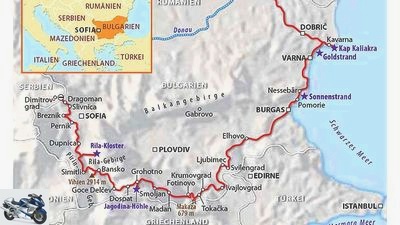
Map: Maucher
Duration of the trip: two weeks; Distance covered: 1370 kilometers.
Practical
An identity card is sufficient to enter Bulgaria; But anyone who drives through the non-EU country Serbia beforehand needs a passport there. The green insurance card should not be missing. The means of payment is the lev (BGN), 1 lev corresponds to around EUR 0.51. Banks or EC machines provide cash, credit cards are often accepted. The supply of petrol is unproblematic, and the Bulgarian petrol stations are even open on Sundays. Opinions differ when it comes to the best travel time: July and August are the hottest months, the temperatures on the plains and by the sea can then be 40 degrees, while it is significantly cooler in the alpine regions. Since the bathing season lasts from May to October and the climate in the interior is also moderate in these six months, even bathing enthusiasts do not necessarily have to choose midsummer for the Balkan trip. Note: Eastern European time applies in Bulgaria, so it is always one hour later than in Germany.
literature
The German edition of Lonely Planet has a wealth of restaurant and accommodation tips “Bulgaria” a very practical travel companion for 19.95 euros. It is also very informative, albeit a little confusing “Discover Bulgaria” from Trescher-Verlag for 16.95 euros. Elaborate color plates on the subject of art and cultural history as well as a large street map offers “Bulgaria” from Baedeker for 19.95 euros. Minimalists grab it “Bulgaria” from Marco Polo for 8.95 euros. The best, also tear-resistant and waterproof road map is recommended “Bulgaria” of travel know-how on a scale of 1: 400,000 for 8.90 euros.
Addresses
Bulgarian Tourist Office, Eckenheimer Landstrasse 101, 60318 Frankfurt / Main, Phone 069/295284, Fax 295286, www.bulgarien-web.de; www.bulgariatravel.org.
Related articles
-
to travel Bulgaria Bulgaria Southeast course Bulgaria – cheap travel destination? A transit country in south-east Europe on the way to Turkey? True, but…
-
Bulgaria with the highest mountains in the Balkans
Deleker to travel Bulgaria with the highest mountains in the Balkans On the way: Bulgaria The highest mountains of the Balkans as a travel destination…
-
to travel Mexico Mexico Change of course What to do when a hard winter suddenly arrives in the land of deserts, beaches and volcanoes? Michael Schroder…
-
Daams to travel Montenegro Montenegro Phoenix from the ashes The southernmost fjord, the deepest canyon and one of the last primeval forests in Europe ??…
-
Breakable 22nd pictures Breakable 1/22 Island happiness: The slender streets of the Isle of Mull enchant especially around the highest mountain Ben More…
-
Piedmont and Hautes-Alpes with Yamaha Tricker
Schulz to travel Piedmont and Hautes-Alpes with Yamaha Tricker Piedmont and Hautes-Alpes with Yamaha Tricker Are you still alive? Then do it! A…
-
to travel South America ?? Antarctic South America ?? Antarctic 42 degrees of latitude On two enduros through the Andes ?? from the Chilean Atacama…
-
to travel Nepal Nepal Once limit value and back With a 500 Enfield to the eight-thousanders on earth. A journey between wooden sheds and pagoda temples…
-
MOTORCYCLE on the road in Morocco
Brings to travel MOTORCYCLE on the road in Morocco MOTORCYCLE on the road in Morocco North Africa’s last gap It has become tight in the northern Sahara….
-
to travel Jordan Jordan No reason to worry Travel to the Arab world after September 11th ?? only something for those who are tired of life? Not at all….